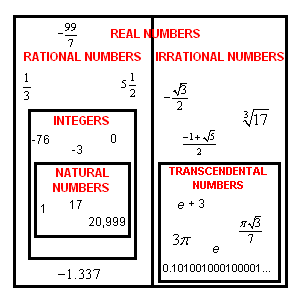Irrational Numbers
An irrational number is a real number that cannot be expressed in the form , when and are integers ( ). In decimal form, it never terminates (ends) or repeats.
The ancient Greeks discovered that not all numbers are rational ; there are equations that cannot be solved using ratios of integers.
The first such equation to be studied was . What number times itself equals ?
is about , because , which is close to . But you'll never hit exactly by squaring a fraction (or terminating decimal ). The square root of is an irrational number, meaning its decimal equivalent goes on forever, with no repeating pattern:
Historical Note:
According to legend, the ancient Greek mathematician who proved that could NOT be written as a ratio of integers made his colleagues so angry that they threw him off a boat and drowned him!
Other famous irrational numbers are the golden ratio , a number with great importance to biology:
(pi) , the ratio of the circumference of a circle to its diameter:
and , the most important number in calculus :
Irrational numbers can be further subdivided into algebraic numbers, which are the solutions of some polynomial equation (like and the golden ratio), and transcendental numbers, which are not the solutions of any polynomial equation. and are both transcendental.
The Venn diagram below shows the relationships of the various sets of numbers.




